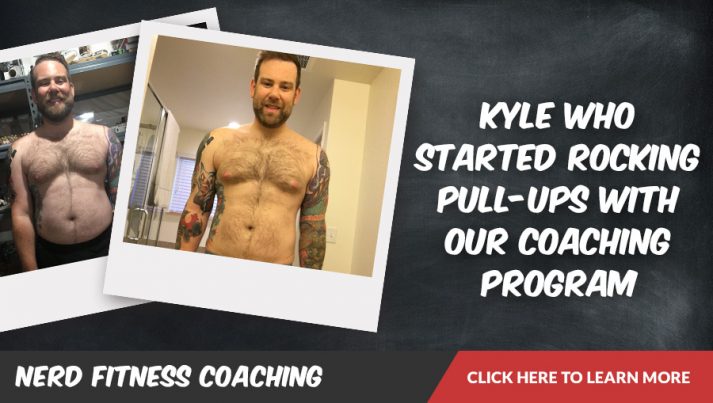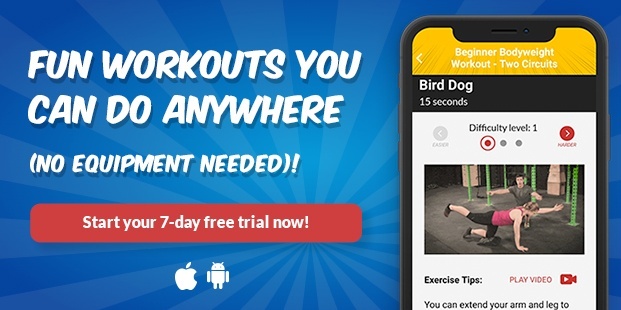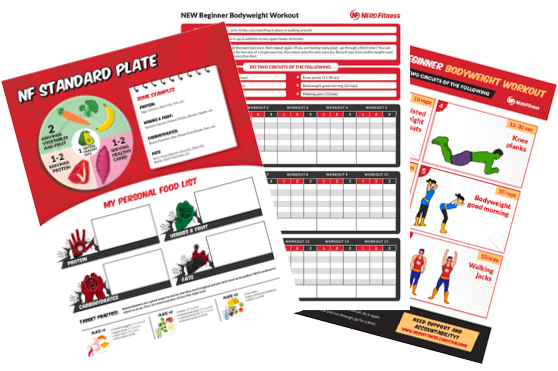
So you want to do a pull-up but don’t have a bar?
Or maybe you just don’t quite have the strength yet to hoist yourself up?
Either way, no problem!
We’ve been teaching people how to do pull-up alternatives in our Online Coaching Program with “no-bar pull-ups.” Today, we’ll show you all these tried and trusted workarounds.
Here’s what we’ll cover:
- How to do pull-ups without a bar (5 pull-up alternatives)
- The 6 best pull-up alternative exercises (How to get your first pull-up)
- What is the easiest type of pull-up? (Start with chin-ups)
- When should I do my pull-up alternatives? (Next steps)
By the way, all of these pull-up alternatives can be swapped in to our ultimate guide for getting your first pull-up. It includes different levels to progress your strength, and sample workouts to complete.
You can grab it right here for free – just tell us where to send it!
Alright, let’s do this thang.
How to Do Pull-ups Without a Bar (5 Pull-up Alternatives)
The video above comes from our Chin-up Challenge (which you can do in our app).
Coach Jim walks you through 5 different levels of pull-up alternatives, depending on your experience level and what items you may have lying around the house.
Pull-up Alternative #1: Doorway Rows
Our first alternative is to simply use your doorway for bodyweight rows.

To perform a doorway row:
- Stand in front of your doorway and grab both sides.
- Place your feet a little closer to the doorway, so you’re leaning back.
- Sit back so you put weight on your arms.
- Pull yourself forward.
That’s it. The more you lean back, the tougher this will be.
To start, you can also just hang back to start building some “pull” strength.

Pull-up Alternative #2: Towel Doorway Rows
Our next alternative is to do doorway rows, but this time using a towel.
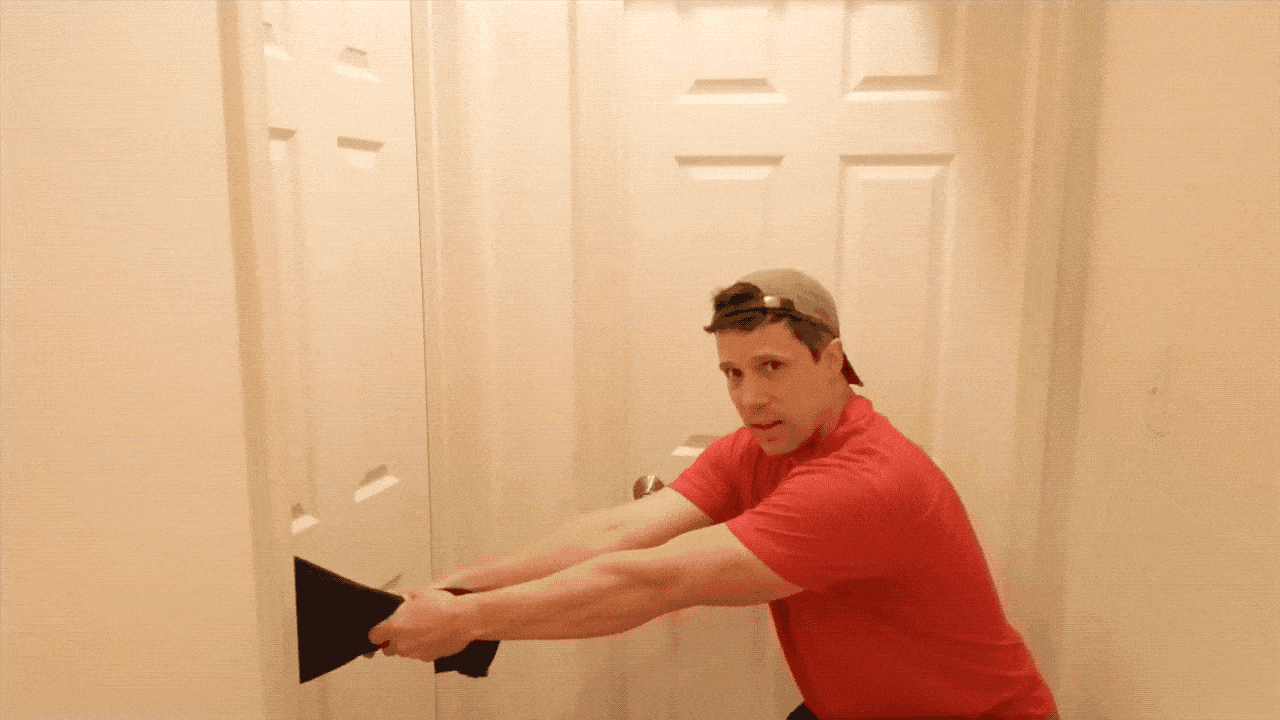
The towel might help you lean back even further, creating a more challenging exercise.
Take a towel, and fold it twice lengthwise. Then take your long, folded-over towel, and tie it around the door on the handle opposite side of you.
Make sure the door opens AWAY from you. You don’t want the door accidentally opening, which could cause an unexpected tumble.
Once you have your towel secured around the doorknob, perform rows by using each side of the towel.
Pull-up Alternative #3: Inverted Rows with Chairs
For this pull-up alternative, you’re gonna need two sturdy chairs and a broomstick (or dowel).
We’ll be combining them together, Voltron style, to form our own row station:

The important thing here is the setup. Give your newly created station a few gentle pushes to check the integrity of the structure. Only when you feel confident should you start performing inverted bodyweight rows.
Pull-up Alternative #4: Towel Pull-ups
Now, we’re gonna start doing some actual pull-ups…with towels.
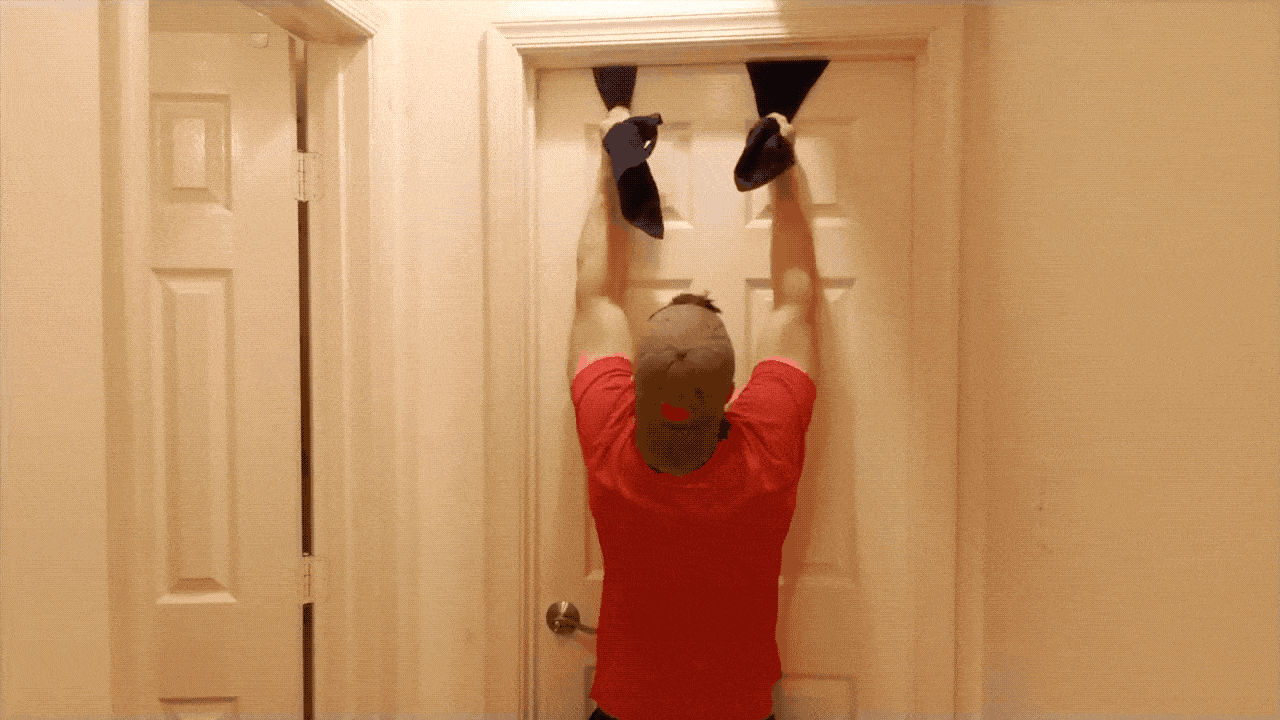
You can either use a couple of sturdy hand towels or washcloths.
Tie an overhand knot in the corner of both towels, which will be used as your anchor.
Then place these knots over a door and close it. Make sure the knots are secure before you start doing your pull-ups.
Again, you’ll also want to make sure the door opens AWAY from you.
Doing towel pull-ups is going to be a great way to improve your grip strength, although if you find them a little too tough, you can use a stool to support your feet as you lift. This will help as you build strength.
Pull-up Alternative #5: Strap Pull-ups
You may or may not have some Forearm Forklifts hanging around, but if you do, you’ll have the perfect equipment for a pull-up alternative.
Forearm Forklifts are made to help you and a friend lift heavy furniture or equipment, but Coach Jim discovered they’re also pretty useful for doing pull-ups.

They have loops designed to hold your arms, which makes them easier to grip than a towel.
Tie a knot in them just like you would with a hand towel and use it to anchor them against your door.
For more ideas on how to train with stuff you may have around the house, check out How to Build a Home Gym.
The 6 Best Pull-up Alternatives (How to Get Your First Pull-Up)

This section is taken from our guide “Get Your First Pull-up.”
If you can’t quite hoist yourself up yet, don’t fret!
We’re going to work on increasing your “pull” muscles through a series of pull-up alternatives.
First up…
Level 1 Pull-up Alternative: Bent-Over Dumbbell Rows
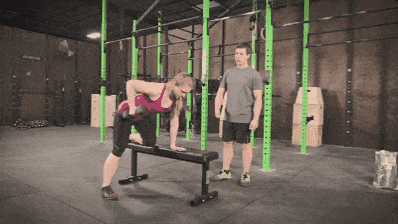
Bent-over dumbbell rows:
- 8 reps each arm (or as many as you can do)
- Rest for a 2-minute break
- Do another set
- Repeat until you hit 3 sets
What weight should you start out with initially?
Whatever allows you to get to at least 5 reps a set.
Once you can do 3 sets of 8 reps (each arm), it’s time to pick up a heavier dumbbell.
This will allow you to get stronger and stronger.
When you can lift a 25-pound (10kg) dumbbell or heavier, consider moving up to the next level.
Level 2 Pull-up Alternative: Inverted Bodyweight Rows
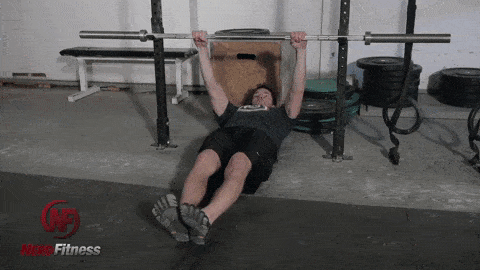
Bodyweight rows are the PERFECT precursor to pull-ups – they work the same muscles, and have you lifting your own body weight, just at a different angle.
Our goal here will be to work towards a lower and lower angle, increasing the difficulty of the movement.
So at first, we’ll do rows with the bar higher up:
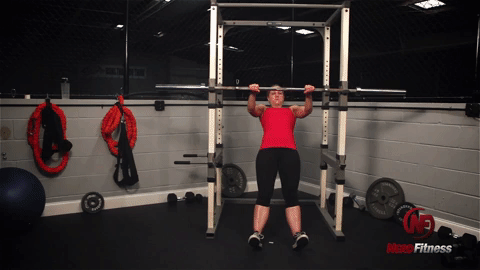
Then we’ll progress to getting the bar lower:
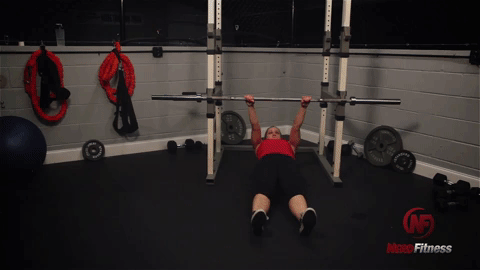
As soon as you’re doing bodyweight rows where your body is at a 45-degree angle or lower, you can progress to the next level.
Level 3 Pull-up Alternative: Assisted Pull-ups
At this point, you are going to start actually doing pull-ups…with a little bit of assistance.
We’ve got a few options for you.
#1) Assisted Pull-ups with Chair
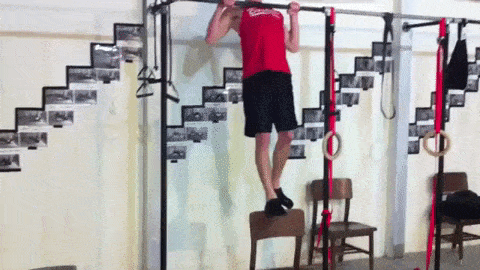
Either one foot or two on the chair, depending on your needs. Your feet are ONLY there for support, use your upper body as much as possible.
#2) Assisted Pull-ups with an Exercise Band
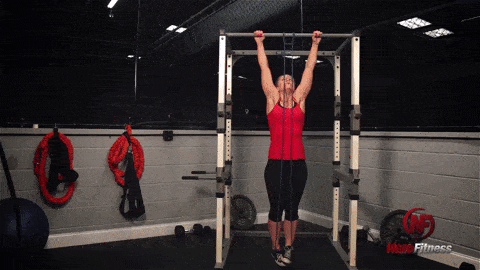
You can get different types of exercise bands with different levels of strength, or a variety pack for easy progression.
Put your foot in the exercise band and pull yourself up.
Here’s a video on How to Tie the Resistance Band for Your Pull-up:
#3) Assisted Pull-ups with a Partner
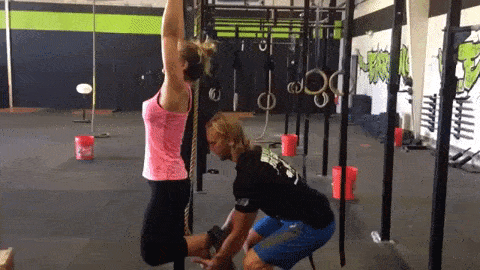
Have a friend hold your feet behind you and help you complete each rep. Have them use the least amount of help possible to get you through your workouts.
Once you’re comfortable doing a form of assisted pull-ups and can do about 10 repetitions, it’s time to advance to the next level.
This is probably the TOUGHEST level before getting your pull-ups. If you get stuck on “assisted pull-ups” and “assisted chin-ups”, you’re not alone. This is where most people get stuck.
We work hand-in-hand with people like you to get them their first pull-up in our Online Coaching Program. If you don’t know how to fit these movements into your workouts, or you just want somebody to give you the exact workout to follow every day, we got you!
Level 4 Pull-Up Workout: Negative Pull-Ups
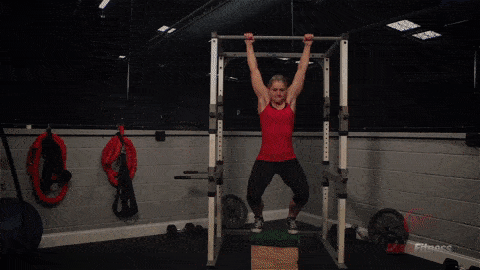
Our next level on our path for a pull-up is what we call “negative pull-ups.”
- Grab onto the bar with an overhand grip
- Jump so your chest is touching
- Slowly lower yourself under control until you’re at the bottom of the movement.
As you continue to lower yourself down, you’ll build strength, eventually creating enough muscle so you can pull yourself up.
If you want more specific instructions on any of these levels or movements, check out our guide “Get Your First Pull-up” for more.
What Is the Easiest Type of Pull-Up? (Start With Chin-Ups)
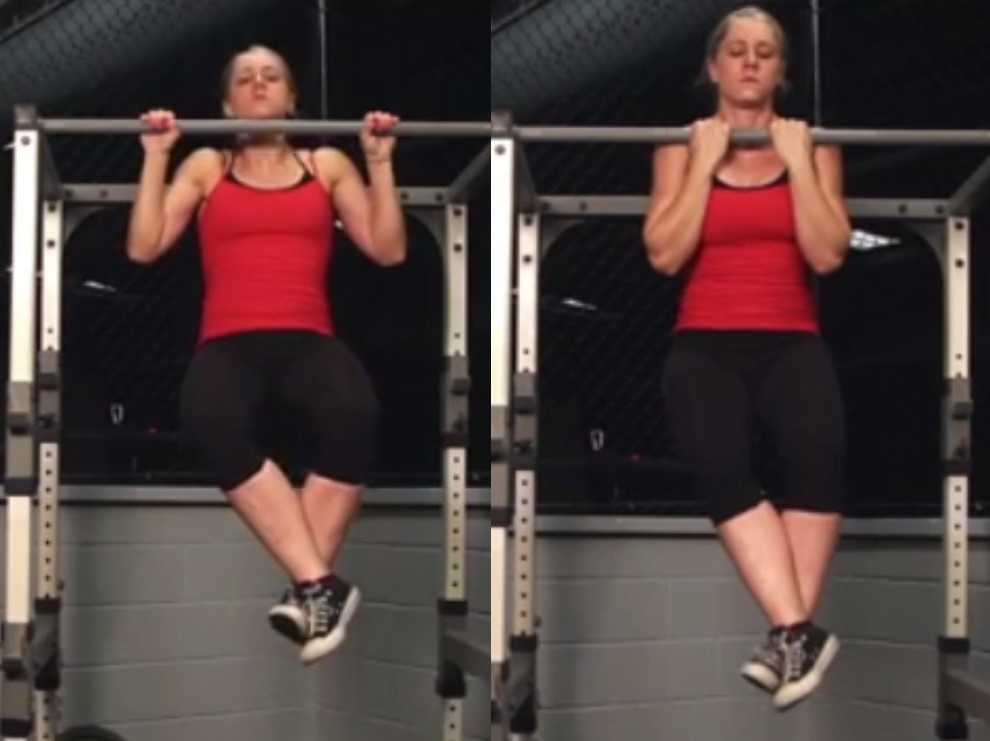
The easiest pull-up variation for you to attempt will likely be the chin-up.
That’s why we have a Chin-up Challenge in our app, because we feel Rebels will have an easier time lifting themselves up with this variation, compared to a traditional pull-up.
For reference:
A CHIN-UP is when your hands are facing toward you:
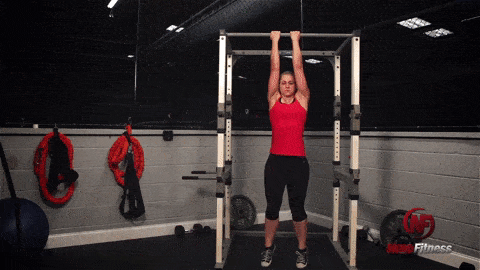
A PULL-UP is when your hands are facing away from you:
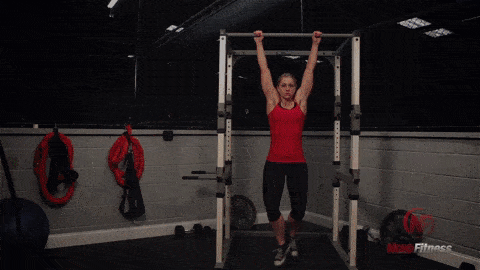
Chin-ups are generally easier to perform than pull-ups because the wider grip of a pull-up isolates your lats, which means you get less assistance from your biceps.
Start with chin-ups. Once you get comfortable doing them, you can then work on more advanced variations. For ideas here, check out our guide How to Do a Pull-up.
When Should I Do My Pull-Up Alternatives? (Next Steps)

Generally, you want a 48 to 72-hour resting period before returning to train the same muscle group.
So take at least a day off before working on your “pull” muscles again.
This allows the area to heal properly so you can grow stronger.
When we designed a training routine for Nerd Fitness Prime members to get their first chin-up, we aimed for three workouts a week.
If you’re trying to get your first pull-up or chin-up, this would be a good goal.
So for example, you could do:
- Monday: Bodyweight Rows
- Wednesday: Chin-up Negatives
- Friday: Dumbbell Rows
You could also do Tuesday, Thursday, and Saturday.
Even just working out Monday and Thursday – twice a week pull-up training – would allow you to see some great progress.
Feel free to do whatever works best for you.

If you want any more help with designing your workout, we got you.
Check out the option that best fits your goals:
Option #1) If you want a professional coach in your pocket, who can do video form checks, provide feedback, and adjust your workouts based on the equipment you have available, check out our 1-on-1 Online Coaching Program!
For example, let’s say you find yourself stuck indoors during a pandemic, and you want somebody to custom-build you a workout program based on the equipment and furniture you have. That’s where an online coach is a game-changer!
Personally, I’ve been working with the same online coach since 2015 and it’s changed my life. You can learn more by clicking on the image below:
Option #2) Exercising at home and need a plan to follow? Check out Nerd Fitness Journey!
Our fun habit-building app helps you exercise more frequently, eat healthier, and level up your life (literally).
Plus, it’ll teach you how to do pull-ups, even if you have zero experience (or any equipment).
Try your free trial right here:
Option #3) Become part of the Rebellion! We need good people like you in our community, the Nerd Fitness Rebellion.
Enlist below and we’ll send you our free Strength Training 101: Everything You Need to Know:
Alright, now I want to hear from you!
Can you currently do a chin-up or pull-up?
What’s your favorite pull-up alternative?
Am I missing any tips or tricks for pull-ups without a bar?
Let me know in the comments!
-Steve
PS: If you want more pull-up goodness, make sure you check out:
- Get Your First Pull-Up (30-Day Progression Plan)
- How to Do a Proper Pull-up
- 5 Common Mistakes When Doing Pull-ups
###
Photo source: Kermit and Pink Panther, Mouse Hanging, Scarlet Spider-man

